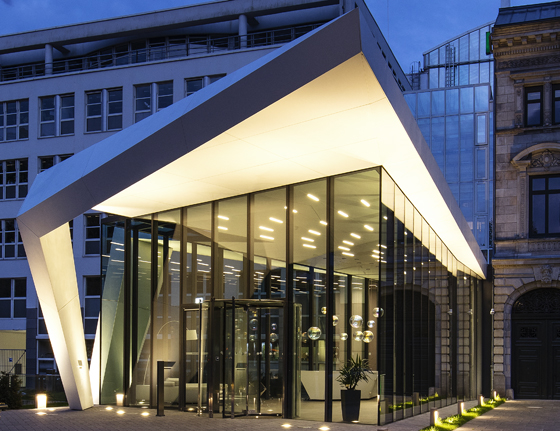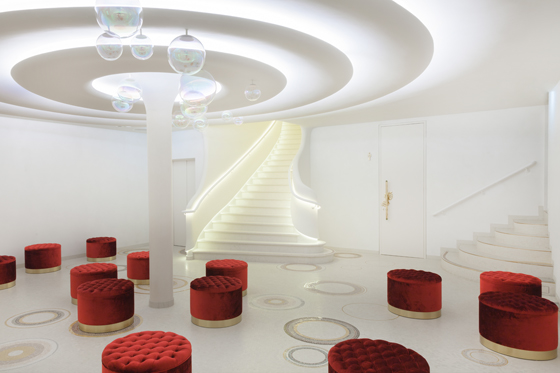Global phenomenon: NEO/CRAFT's Iris pendant light
Brand story by Barbara Jahn-Rösel
Wien, Austria
22.01.18
Young Berlin-based designer Sebastian Scherer is never happy with the status quo of things. To achieve his creative visions, his company NEO/CRAFT pushes materials to the limit – and beyond.
Iris makes an extremely light impression. The blown-glass orb makes no secret of its affinity with soap bubbles, even shimmering like them in gorgeous, if subtle, colours
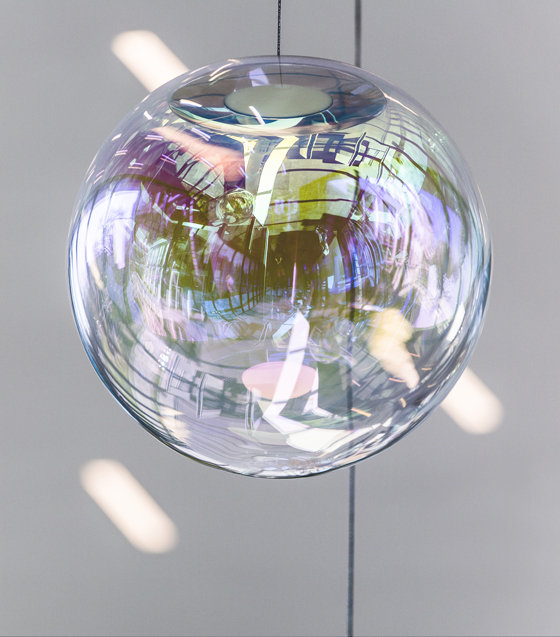
Iris makes an extremely light impression. The blown-glass orb makes no secret of its affinity with soap bubbles, even shimmering like them in gorgeous, if subtle, colours
×It all began with Iris. When the young Berlin designer Sebastian Scherer won the 2014 Lexus Design Award for this lamp – which he had designed in 2013 and presented just a year later as a ten-piece collection at the imm cologne – it was time to found his own label: NEO/CRAFT. As the name suggests, this ambitious young design laboratory combines traditional craft with modern technology.
Eigentlich hat mit ihr alles begonnen. Als der junge Berliner Designer Sebastian Scherer 2014 den Lexus Design Award für die Leuchte Iris erhielt, die er im Jahr zuvor entworfen hatte und ein Jahr danach bereits als zehnteilige Kollektion auf der imm cologne präsentierte, war der richtige Zeitpunkt, das eigene Label zu gründen: NEO/CRAFT. Wie der Name bereits verrät, verbindet sich in diesem aufstrebenden jungen Designlabor traditionelles Handwerk mit moderner Technologie.
Luminous. The sober architecture of the foyer of the HanseMerkur building in Hamburg is imbued with an almost dreamy atmosphere by nine iridescently radiant spheres in three different sizes
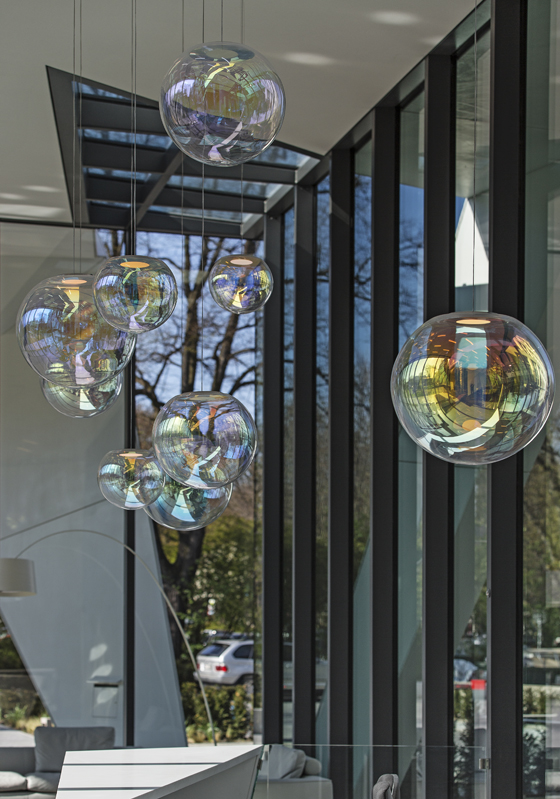
Luminous. The sober architecture of the foyer of the HanseMerkur building in Hamburg is imbued with an almost dreamy atmosphere by nine iridescently radiant spheres in three different sizes
×Joy of experimentation
Sebastian Scherer and his team are open to everything having to do with living and dwelling. From accessories to furniture – the scale doesn’t matter as long as the task is demanding and challenging. The focus of their activity lies in the processing of aluminium, steel, glass and wood. At NEO/CRAFT, they like to push a material to its limits, translating its properties into new products by unconventional means. “I see myself as a researcher who works in a goal-oriented way – although the path is an open process,” says Scherer, who prizes premium materials and flawless execution.
Getting the most out of the materials is one of the designer’s chief driving forces. “The development of each product is essentially a research process that illuminates the artistic expression of the object,” Scherer explains. “The manufacturing technology needed to realise an idea determines the choice of materials.” Scherer not only likes to work at the computer, but also possesses a deep trust in his own intuition and haptic sensibility.
In the emphatically geometric design of the HanseMerkur lobby, the subtle artistic spirit of the Iris installation offers a welcome contrast for the eyes and mind
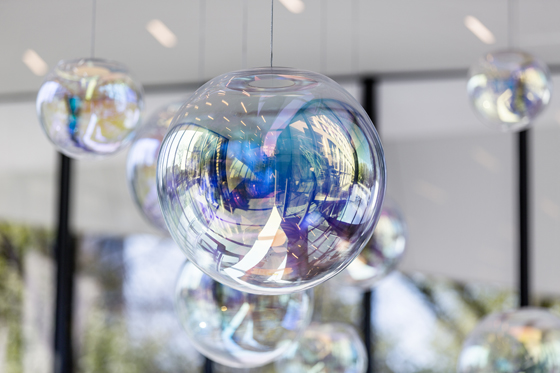
In the emphatically geometric design of the HanseMerkur lobby, the subtle artistic spirit of the Iris installation offers a welcome contrast for the eyes and mind
×Instinct-driven
Scherer’s search for the extraordinary is a tricky balancing act in times like these, in which anything goes, yet everything seems already to have been invented. “I’m curious to create something new and, in doing so, to break through supposed limits,” he says. “My products reflect the zeitgeist without being trendy – they look modern yet timeless,” Scherer is convinced. “I want to create furniture and home accessories that are functionally and technically ambitious, but also novel, expressive and innovative.”
In the Iris lamp, he has unquestionably achieved this. At first glance, the iridescent sphere has the appearance of an oversized soap bubble, bringing back childhood memories. “The idea for Iris came to me on a visit to the Milan furniture fair, when I was watching children playing with soap bubbles,” Scherer recalls. “Straight away, I thought it would be interesting to develop a luminaire with the aesthetic qualities of a soap bubble.” During the design process, he “looked for a way to give the idea physical form. The Iris lamp consists of a blown-glass ball that’s worked in the laboratory using a technique called dichroic coating.”
Floating bubbles. In her installation in the toilet entry area at Berlin’s Wintergarten theatre, artist Fiona Bennett casts Iris in a purely aesthetic role. Here, a custom design invokes the magic of the spheres without their lighting function
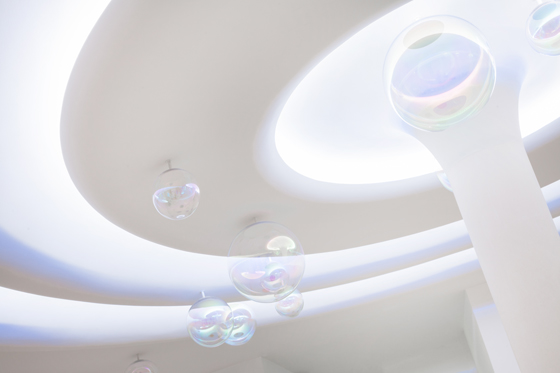
Floating bubbles. In her installation in the toilet entry area at Berlin’s Wintergarten theatre, artist Fiona Bennett casts Iris in a purely aesthetic role. Here, a custom design invokes the magic of the spheres without their lighting function
×Visions realised
The captivating shimmer now graces two prominent projects in which Iris is employed as a hovering bubble. In 2016, Fionn Mögel and Wasfy Taha of Querkopf Architekten discovered the lamp at imm cologne and decided to integrate it in their interior design for the HanseMerkur insurance company. Nine of the lamps in three different diameters illuminate the high-ceilinged, daylight-flooded lobby like an art installation, their splendid play of colours infusing the glass-and-steel architecture with a special atmosphere.
Another designer to take a shine to Iris was the artist Fiona Bennett, who used the lamp in restyling the toilet facilities of the Wintergarten variety theatre in Berlin. The blown-glass spheres enabled her to realise her vision of floating soap bubbles in the generous anteroom. NEO/CRAFT collaborated with a Bavarian Forest glass-blowing workshop to develop a custom design for the project. Since September 2017, the opalescent orbs have embellished the entry area to the toilets of the cultural hotspot, where they hang from the ceiling on delicate rods, in this case without a lighting function.
An all-round success: Sebastian Scherer and his masterpiece. The designer likes to look to everyday things and actions for inspiration. With his oversized soap bubble, he has ascended to design-world prominence
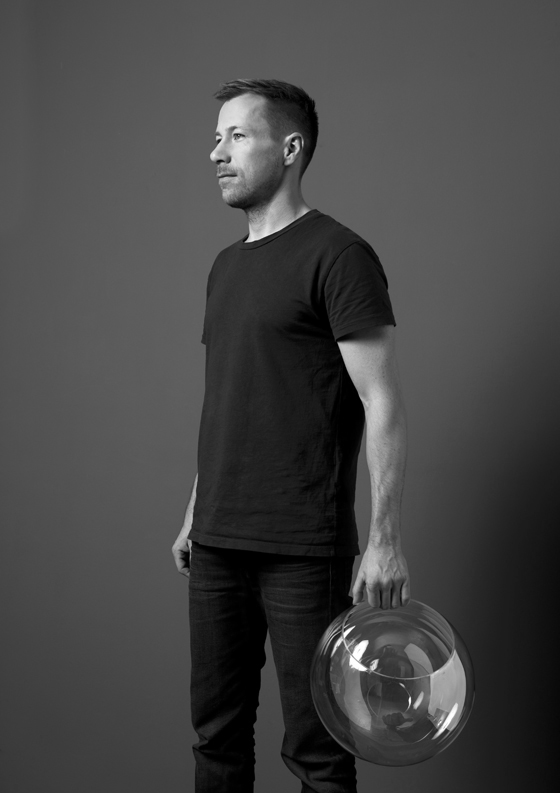
An all-round success: Sebastian Scherer and his masterpiece. The designer likes to look to everyday things and actions for inspiration. With his oversized soap bubble, he has ascended to design-world prominence
×What’s behind it all
“Everything that surrounds me is inspiration. It can be nature – or architecture, graphic patterns or simply soap bubbles,” Sebastian Scherer explains. “Everyday things inspire me just as much as fashion, the zeitgeist or art. Then, in the work process, I try to give shape to my ideas.” Taking things as they are, and looking at them for what they could be, is clearly a key ingredient in his formula for success.
© Architonic

